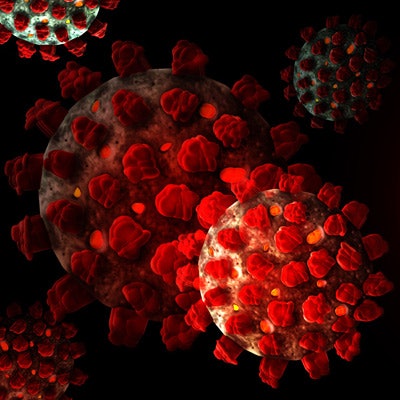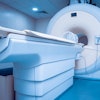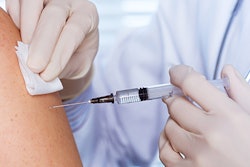
Although COVID-19 typically manifests as a respiratory illness, the disease can affect many nonpulmonary body systems, according to a presentation delivered Monday afternoon at the RSNA 2020 virtual meeting.
These other body systems include the gastrointestinal or genital tracts, as well as the splenic, renal, and musculoskeletal systems, presenter Dr. Margarita Revzin of Yale University in New Haven, CT, told session attendees.
"Although COVID-19 predominantly affects the respiratory system, many other organ systems can be involved," she said. "The virus can cause direct tissue or endothelial damage, thrombo-inflammation, and a dysregulation of immune response."
The COVID-19 pandemic has now affected every country in the world, and as of this October, the SARS-CoV-2 virus has infected more than 38 million people globally with more than 1 million dying, according to Revzin. Yet along the way, imaging -- including ultrasound, CT, CT angiography, and MRI -- has proved to be a crucial tool for evaluating the disease's impact.
"Imaging plays an essential role in detection, diagnosis, assessment, and follow-up of virus-induced injury and associated complications," she told session attendees.
COVID-19's far-reaching effects
Revzin offered an overview of some of COVID-19's nonpulmonary manifestations and the imaging findings associated with them.
Gastrointestinal tract
- Gastritis and colitis -- Thickening of gastric wall, mucosal hyperenhancement, hepatic steatosis, thickening of ascending and descending colon.
- Gastric ischemia and necrosis -- May be characterized by marked gastric wall thickening, patchy airspace disease in lung bases, and areas of ulcerations and diffuse hemorrhage.
- Enterocolitis -- Thickening of the bowel wall in almost a third of patients due to submucosal edema; can also look like graft-versus-host disease. Forty-three percent of patients may show fluid-filled intestinal lumen. Also look for mucosal hyperenhancement due to bowel fold edema.
- Proctocolitis -- Appears on imaging and marked edema of the distended rectal wall, hyperenhancing mucosa, and inflammatory changes in surrounding tissues.
- Acute mesenteric ischemia, arterial thrombosis -- Thick-walled, edematous, fluid-filled nondilated bowel raises suspicion for this condition.
- Acute mesenteric ischemia, venous thrombosis -- Portal, splenic, and superior mesenteric vein thrombosis and congestion; distended veins with filling defect.
Kidneys
- Of patients admitted to hospitals, particularly intensive care units, 20% to 40% develop kidney injury from COVID-19, Revzin said, which can manifest as acute tubular necrosis, interstitial inflammation, or microangiopathy. Ultrasound may show increased cortical echogenicity or heterogeneity, but CT may be nonspecific.
- Renal infarcts -- For these injuries, Revzin has seen multiple cortical linear hypoattenuating areas, focal areas of hypoperfusion in the upper pole of the left kidney, and ascites bowel wall edema.
- Splenic infarcts -- Found in 18% of patients, according to Revzin. They manifest on imaging as hypoattenuated wedge-shaped areas in the solid organ parenchyma. Radiologists may also see vascular thrombosis as a filling defect on CT or ultrasound.
Vascular system
- Hypercoagulopathy, venous thrombosis -- Look for thrombosis/occlusion of various veins in the abdomen and pelvis (renal, ovarian, and deep pelvic veins).
Hepatobiliary system
- The liver is the most frequent organ outside of the respiratory system damaged by COVID-19, with 14% to 53% of patients showing elevated liver function tests and biliary stasis, Revzin said. Imaging shows heterogeneous hepatic enhancement with areas of hypoenhancement along the biliary tract and distended gallbladder.
- Biliary stasis and acute cholecystitis -- "Fifty-four percent of COVID-19 patients have sludge and stones within a dilated gallbladder due to cholestasis," she said. Imaging also shows wall edema and hyperemia.
Genitourinary system
- Viral cystitis, splenic and renal infarcts, stroke -- Diffuse irregularity and wall thickening of the urinary bladder.
- Urinary bladder hemorrhage -- Ultrasound is helpful here for initial diagnosis, Revzin noted. Imaging may show a distended urinary bladder filled with avascular heterogeneous echogenic material.
Musculoskeletal system
- Rhabdomyolysis -- On imaging, Revzin has seen enlarged right gluteal regions without associated fracture and multiple segmental and subsegmental right lower lobe pulmonary emboli.
Don't mess with COVID-19
COVID-19 has high morbidity and mortality and can affect the whole body, Revzin said, with the virus targeting abdominal and pelvic organs -- which, in some cases, can result in failure of those organs.
"Understanding the virus's pathophysiology and its effects on the immune system and coagulation is essential for accurate identification of associated complications," she concluded. "The recognition of one complication should prompt scrutiny for others, particularly if patients are critically ill."




.fFmgij6Hin.png?auto=compress%2Cformat&fit=crop&h=100&q=70&w=100)




.fFmgij6Hin.png?auto=compress%2Cformat&fit=crop&h=167&q=70&w=250)











